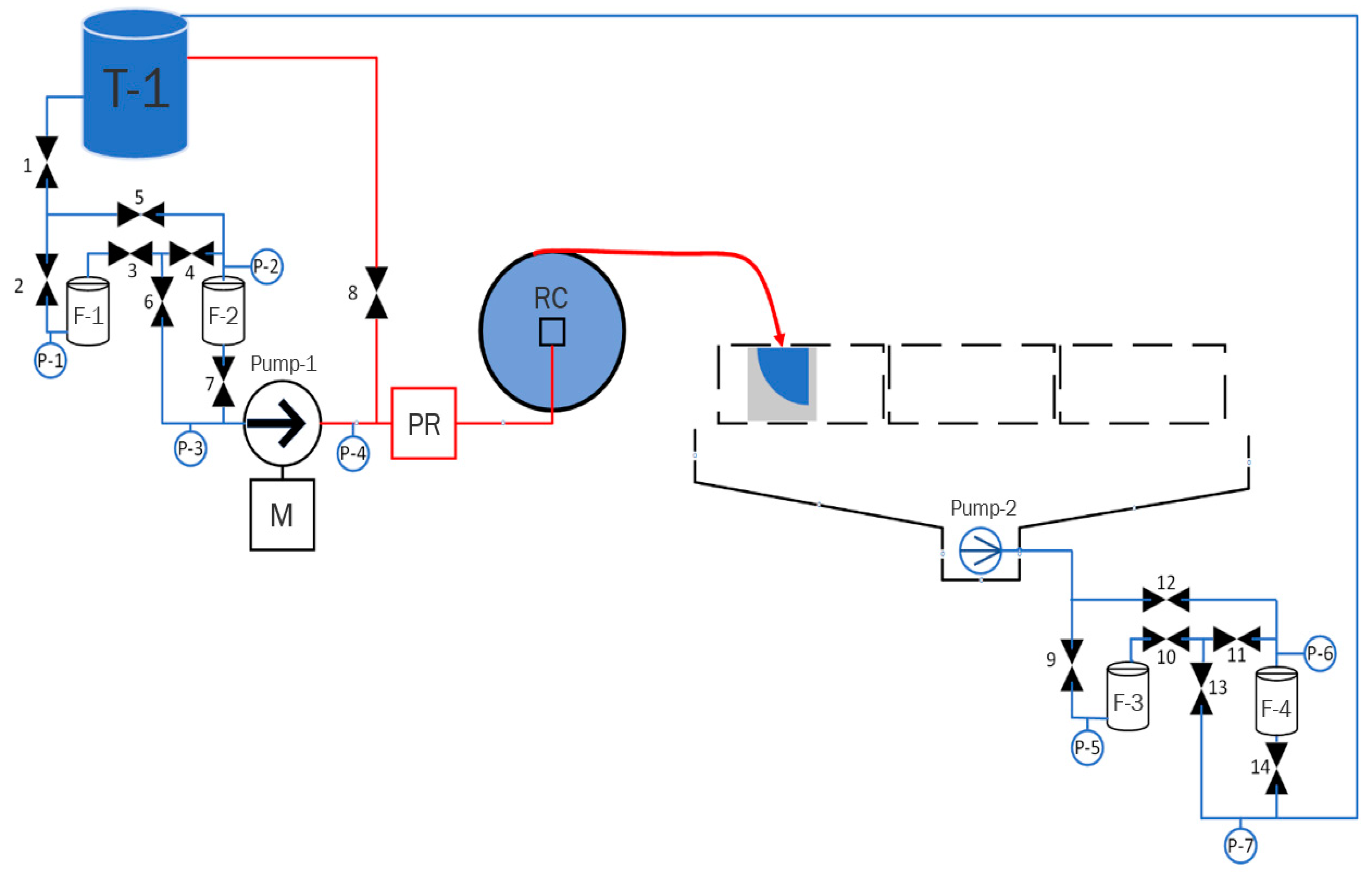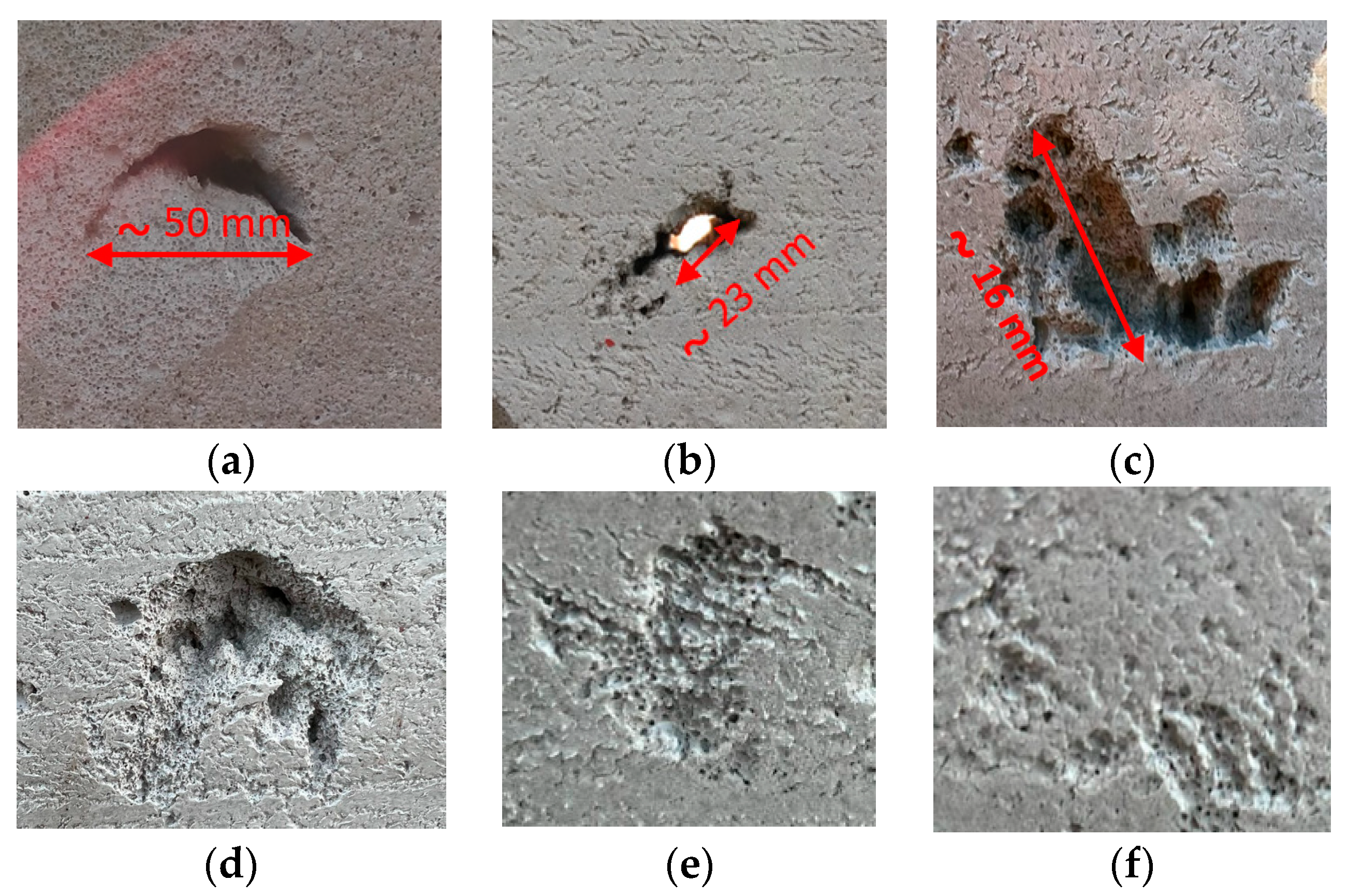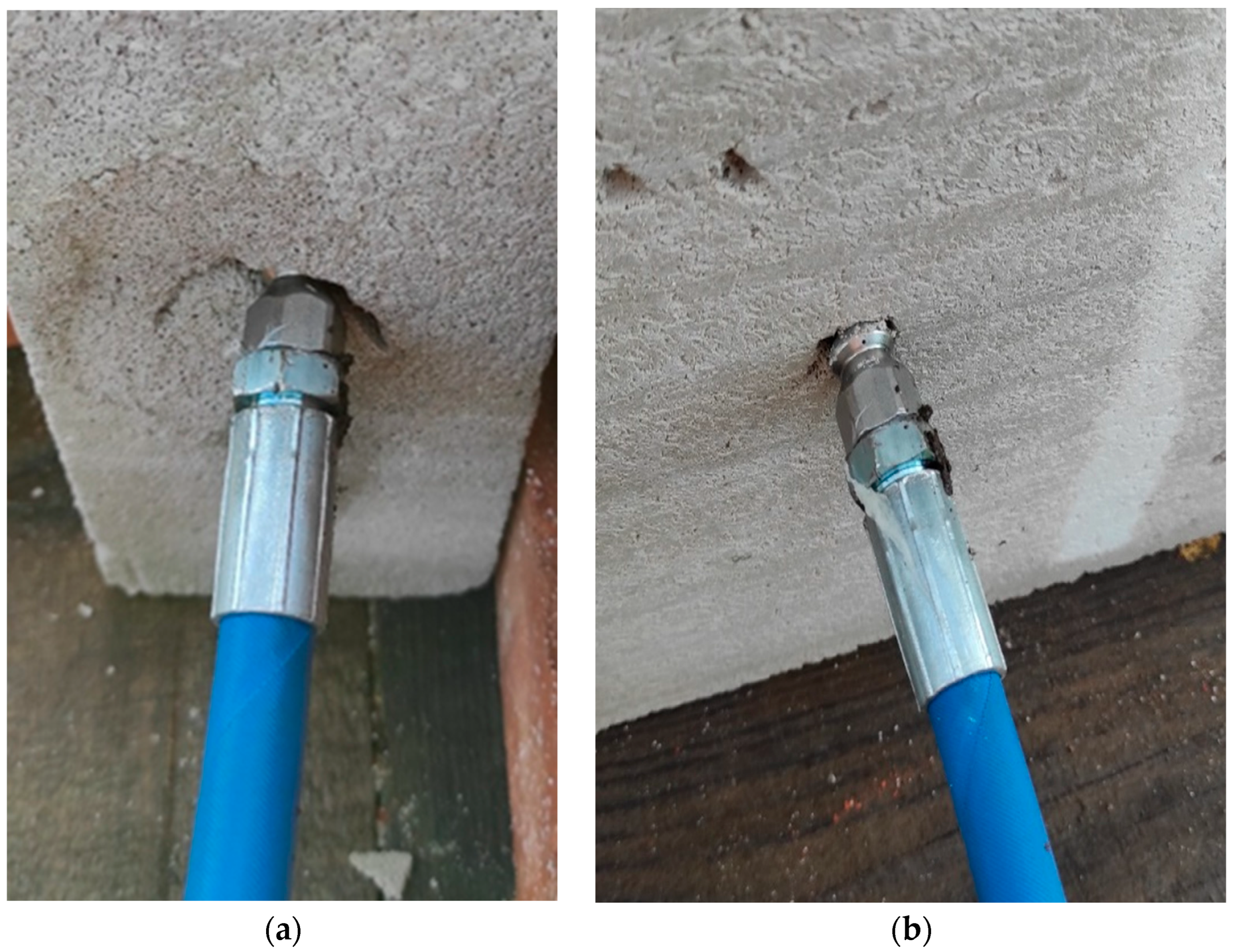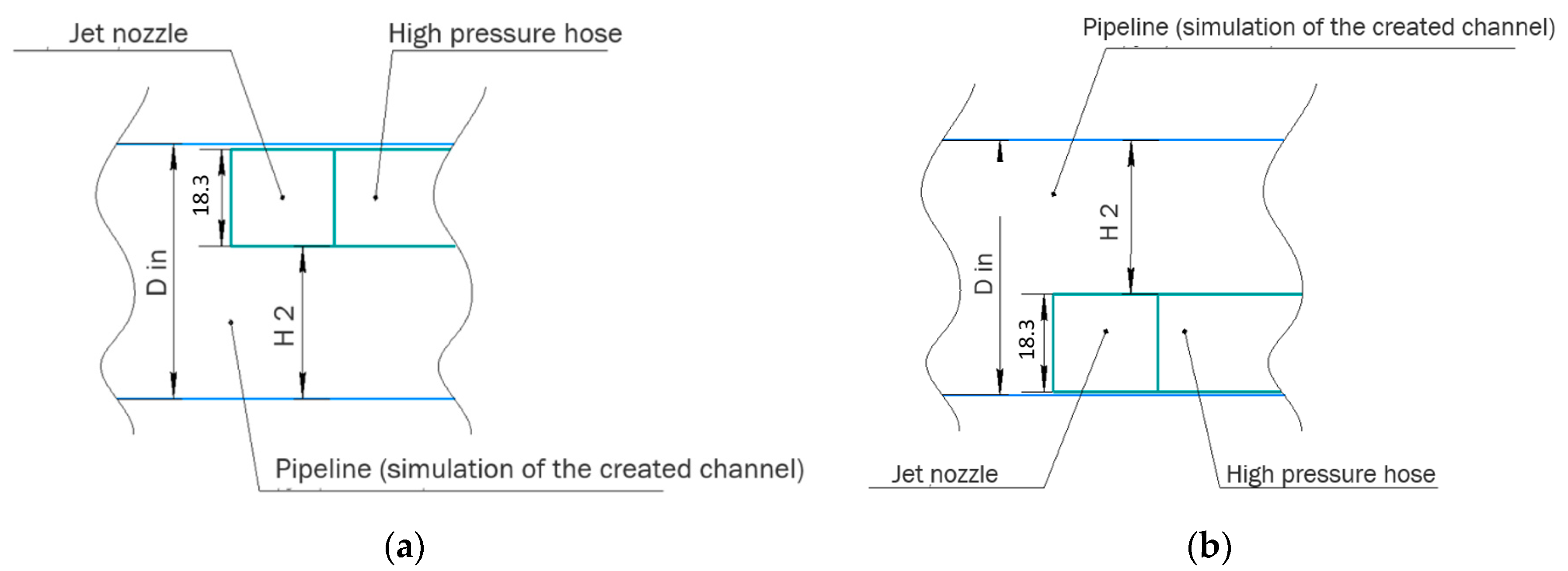Experimental Study of Different Radial Jet Drilling Parameters and Operation Regimes for Effective Well Stimulation
Abstract
1. Introduction
- Self-propulsion capability of the waterjet nozzle decreases significantly as the number of front holes increases.
- The angle of the front holes has a negligible effect on the self-propulsion capability of a waterjet nozzle.
- An increase in the number of rear holes increases the self-propulsion force and contributes to the radial bore expansion.
- The angle of the rear holes significantly affects the self-propulsion capability of the waterjet nozzle and the diameter of the radial channel that is being drilled. However, exact determination of the optimum rear hole angle remains an open question.
2. Materials and Methods
3. Results
3.1. Results of Experiments for Drilling Radial Channels Using Waterjet Method in Laboratory Conditions under Static and Dynamic Stimulation Modes
3.2. Results of Determining the Optimal Values of Operating Parameters of Waterjet Nozzle Movement Speed along the Waterjet Channel Being Drilled
4. Discussion of the Obtained Results
4.1. Peculiarities of Dynamic and Static Waterjet Stimulation
- The dynamic mode of stimulation appears to be much more effective and high-performing in comparison with the static mode, because over the same period of time, the dynamic mode of operation resulted in a waterjet channel through which the waterjet nozzle can be advanced further. When the back-and-forth motion is created, the rock is cut and abraded. Also, the presence of a constantly changing distance between the nozzle and the frontal wall of the created channel makes a significant effect in the destruction of the rock in front of itself. In the case of static impact, the hydromonitor nozzle is tightly pressed with the frontal part into the rock, which does not allow the front jets to cover a large cross-sectional area of the created channel. Thus, the required channel expansion does not occur so that the hydrodynamic nozzle can move forward and connect the rear jets to the channel expansion process.
- Expansion of the waterjet channel is accomplished due to the effect of the rear jets of the nozzle. Similar results were also obtained and published in [7].
4.2. Results of Determining the Optimal Values of Operating Parameters Affecting the Speed of Movement of the Waterjet Nozzle along the Created Waterjet Channel
5. Conclusions
- The optimum ratio of the number of front-to-rear diffusers (assuming they have the same diameter) is 1/3.
- The permissible number of front diffusers is at least three.
- The value of the specific flow rate of the working agent per unit of total area of the front and rear diffusers shall tend to 26.75 L/(min-mm2).
- The proposed calculation coefficients should be within: Knom ≥ 1.86, Kactual ≥ 0.93.
Author Contributions
Funding
Institutional Review Board Statement
Informed Consent Statement
Data Availability Statement
Conflicts of Interest
References
- Chi, H.; Li, G.; Huang, Z.; Tian, S.; Song, X. Maximum drillable length of the radial horizontal micro-hole drilled with multiple high-pressure water jets. J. Nat. Gas Sci. Eng. 2015, 26, 1042–1049. [Google Scholar] [CrossRef]
- Huang, Z.; Huang, Z.; Su, Y.; Li, W.; Jiang, T. Where the laterals go? A feasible way for the trajectory measurement of radial jet drilling wells. In Proceedings of the SPE Asia Pacific Oil and Gas Conference and Exhibition, Brisbane, Australia, 23–25 October 2018. [Google Scholar] [CrossRef]
- Ibeh, S.; Obah, B.; Chibueze, S. Investigating the application of radial drilling technique for improved recovery in mature Niger delta oil fields. In Proceedings of the SPE Nigeria Annual International Conference and Exhibition, Lagos, Nigeria, 31 July 2017. [Google Scholar] [CrossRef]
- Ziaja, J.; Movchan, V. Pulling force simulation of jet bits in radial drilling technology. AGH Drill. Oil Gas 2016, 33, 417–424. [Google Scholar] [CrossRef][Green Version]
- Salimzadeh, S.; Grandahl, M.; Medetbekova, M.; Nick, H.M. A novel radial jet drilling stimulation technique for enhancing heat recovery from fractured geothermal reservoirs. Renew. Energy 2019, 139, 395–409. [Google Scholar] [CrossRef]
- Bakin, D.A.; Popova, A.A. Jet drilling technology and its using in oil & gas industry. In Proceedings of the New Technologies for Oil and Gas Regions Conference, Tyumen, Russia, 26 May 2014. [Google Scholar]
- Cinelli, S.D.; Kamel, A.H. Novel technique to drill horizontal laterals revitalizes aging field. In Proceedings of the SPE/IADC Drilling Conference and Exhibition, Amsterdam, The Netherlands, 5–7 March 2013. [Google Scholar] [CrossRef]
- Ragab, A.M.S. Improving well productivity in an Egyptian oil field using radial drilling technique. J. Pet. Gas Eng. 2013, 4, 103–117. [Google Scholar] [CrossRef]
- Paveleva, O.N.; Popova, Z.S. Analysis of the effectiveness of the use of advanced technology for drilling deep radial channels at the Vakhitovskoye field. In Proceedings of the Geology and Oil and Gas Potential of the West Siberian Megabasin (Experience, Innovations), Tyumen, Russia, 24 November 2016. [Google Scholar]
- Jain, D.; Maut, P.P.; Saharia, P.; Dutta, R.; Yomdo, S.; Hatchell, I.; Mukherjee, A. Radial jet drilling in mature fields of Oil India Limited-an experimental approach. In Proceedings of the SPE Oil and Gas India Conference and Exhibition, Mumbai, India, 4–6 April 2017. [Google Scholar] [CrossRef]
- Medetbekova, M.; Christensen, H.F.; Amour, F.; Salimzadeh, S.; Nick, H.M. High pressure jet drilling effect in chalk and alteration of local geomechanics properties surrounding the radial hole. Int. J. Mech. Sci. 2021, 191, 105954. [Google Scholar] [CrossRef]
- Toczek, P.; Wisniowski, R.; Zlotkowski, A.; Teper, W. Hydraulic Radial Drilling Using a Rotary Hydraulic Nozzle Aimed at Increasing the Exploitation of Deposits. Energies 2023, 16, 7867. [Google Scholar]
- Medetbekova, M.K.; Christensen, H.F.; Salimzadeh, S.; Bakker, R.R.; Nick, H.M. Experimental investigation of drilling lateral boreholes in chalk rocks with high-pressure jets. Int. J. Geomech. 2020, 20, 04020049. [Google Scholar] [CrossRef]
- Novokreschennykh, D.V.; Raspopov, A.V. Prospects for the development of technologies for radial opening of the reservoir in the fields of the Perm Region. Oil Ind. 2014, 3, 54–57. [Google Scholar]
- Raspopov, A.V.; Kondratiev, S.A.; Novokreschennykh, D.V. Influence of geological and physical conditions on the efficiency of drilling radial channels into the near-well zone of the formation. Oil Ind. 2012, 3, 78–79. [Google Scholar]
- Huang, F.; Zhu, Z.; Wang, J.; Zhang, P.; Ren, Z.; Lu, J.; Su, H.; Zhang, H.; Li, J. Study on Energy Conversion Efficiency and Structure Optimization of the Multorifices Nozzle for Radial Jet Drilling. Geofluids 2023, 2023, 5517260. [Google Scholar] [CrossRef]
- Fu, B.; Zhang, S.; Liu, S.; Zhu, Z. Drilling performance analysis of a new type of direct-rotating mixed-jet nozzle. J. Pet. Sci. Eng. 2021, 200, 108302. [Google Scholar] [CrossRef]
- Li, J.; Dai, J.; Huang, Z.; Zhang, G.; Liu, X.; Li, H. Rock breaking characteristics of the self-rotating multi-orifice nozzle for sandstone radial jet drilling. Rock Mech. Rock Eng. 2021, 54, 5603–5615. [Google Scholar] [CrossRef]
- Meng, Q.; Liu, Y.; Qin, X.; Dou, Z.; Zhang, J.; Zhang, J.; Yang, G. Investigation on the Critical Flow Rate of Cuttings Transport in Coiled Tubing Sidetracking by Using a CFD-DEM Coupled Model. Arab. J. Sci. Eng. 2022, 48, 9311–9327. [Google Scholar] [CrossRef]
- Li, J.; Li, G.; Huang, Z.; Song, X.; Yang, R.; Peng, K. The self-propelled force model of a multi-orifice nozzle for radial jet drilling. J. Nat. Gas Sci. Eng. 2015, 24, 441–448. [Google Scholar] [CrossRef]








| Item on the Process Flow Diagram | Technical Characteristics |
|---|---|
| H-1 | Maximum throughput 1260 L/h (21 L/min) Working pressure 480–500 bar |
| Gasoline engine | Motor power 35 hp (25.74 kW) Fuel consumption 3.8 L/h |
| Red line (high-pressure flexible hose) | Hose length 100 m Inner diameter DN, 8 mm Outer diameter, 14.5 mm Working pressure WP 600 bar Burst pressure BP 2400 bar |
| Nozzle Number | Image of the Manufactured Nozzle | Nozzle Type | Number of Diffusers on the Front Part/Diameter of One Diffuser, mm | Number of Diffusers on the Rear Part/Diameter of One Diffuser, mm | Ratio of the Area of the Front Diffusers to the Rear Diffusers |
|---|---|---|---|---|---|
| No.1 |  | Through-type | 1/0.5 | 3/0.5 | 0.33 (3) |
| No.2 |  | Through-type | 1/0.5 | 3/1.0 | 0.083 (3) |
| No.3 |  | Through-type | 4/0.5 | 4/1.0 | 0.33 (3) |
| No.4 |  | Through-type | 4/0.5 | 6/1.0 | 0.16 (6) |
| No.5 |  | Through-type | 5/0.7 | 6/1.0 | 0.408 (3) |
| No.6 |  | Through-type | 5/0.7 | 6/1.2 | 0.283 |
| Waterjet Nozzle Arrangement No. | Number of Diffusers on the Front Part/Diameter of One Diffuser, mm | Number of Diffusers on the Rear Part/Diameter of One Diffuser, mm | Specific Flow Rate of the Working Agent Per Unit of Cumulative Area of Front and Rear Diffusers, L/(min × mm2) |
|---|---|---|---|
| 1 | 1/0.5 | 3/0.5 | 26.75 |
| 2 | 1/0.5 | 3/1.0 | 8.23 |
| 3 | 4/0.5 | 4/1.0 | 5.35 |
| 4 | 4/0.5 | 6/1.0 | 3.82 |
| 5 | 5/0.7 | 6/1.0 | 3.17 |
| 6 | 5/0.7 | 6/1.2 | 2.41 |
| Mode No. | Din, mm | Working Agent Flow Rate, L/min | Average Time of 10-m Section Passage, s | ||
|---|---|---|---|---|---|
| 1 | 48 | 21 | 7.52 | 1.23 | 0.62 |
| 2 | 48 | 10.5 | 9.55 | 1.23 | 0.62 |
| 3 | 38 | 21 | 6.59 | 1.86 | 0.93 |
| 4 | 38 | 10.5 | 8.36 | 1.86 | 0.93 |
| 5 | 62 | 21 | 10.84 | 0.84 | 0.42 |
| 6 | 62 | 10.5 | 24.34 | 0.84 | 0.42 |
| 7 | 106 | 21 | 70.11 | 0.42 | 0.21 |
Disclaimer/Publisher’s Note: The statements, opinions and data contained in all publications are solely those of the individual author(s) and contributor(s) and not of MDPI and/or the editor(s). MDPI and/or the editor(s) disclaim responsibility for any injury to people or property resulting from any ideas, methods, instructions or products referred to in the content. |
© 2024 by the authors. Licensee MDPI, Basel, Switzerland. This article is an open access article distributed under the terms and conditions of the Creative Commons Attribution (CC BY) license (https://creativecommons.org/licenses/by/4.0/).
Share and Cite
Krivoshchekov, S.; Kochnev, A.; Ozhgibesov, E.; Yuzhakov, A. Experimental Study of Different Radial Jet Drilling Parameters and Operation Regimes for Effective Well Stimulation. Appl. Sci. 2024, 14, 1149. https://doi.org/10.3390/app14031149
Krivoshchekov S, Kochnev A, Ozhgibesov E, Yuzhakov A. Experimental Study of Different Radial Jet Drilling Parameters and Operation Regimes for Effective Well Stimulation. Applied Sciences. 2024; 14(3):1149. https://doi.org/10.3390/app14031149
Chicago/Turabian StyleKrivoshchekov, Sergey, Alexander Kochnev, Evgeny Ozhgibesov, and Alexey Yuzhakov. 2024. "Experimental Study of Different Radial Jet Drilling Parameters and Operation Regimes for Effective Well Stimulation" Applied Sciences 14, no. 3: 1149. https://doi.org/10.3390/app14031149
APA StyleKrivoshchekov, S., Kochnev, A., Ozhgibesov, E., & Yuzhakov, A. (2024). Experimental Study of Different Radial Jet Drilling Parameters and Operation Regimes for Effective Well Stimulation. Applied Sciences, 14(3), 1149. https://doi.org/10.3390/app14031149






